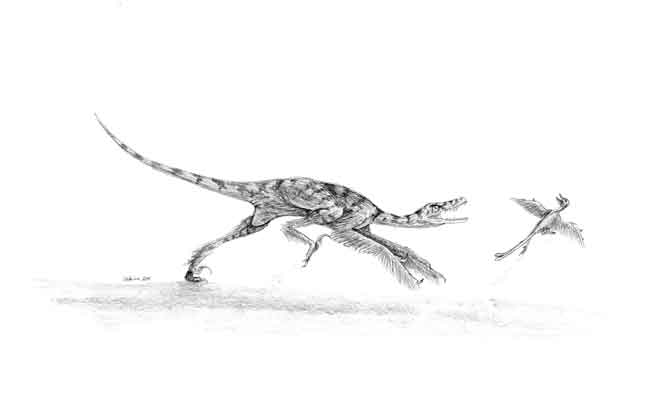Dinosaur Packed Venom in Fangs

Using snake-like fangs, saber-toothed dinosaur relatives of velociraptors likely subdued their prey with venom, scientists now suggest.
Paleontologists analyzed the skulls of Sinornithosaurus, whose name means "Chinese bird lizard." This narrow-snouted raptor was the fifth and most bird-like dinosaur species ever to be discovered, and lived roughly 125 million years ago in the warm, moist forests of northeastern China during the late Cretaceous.
"This is an animal about the size of a turkey," said researcher Larry Martin, curator of vertebrate paleontology at the University of Kansas Natural History Museum in Lawrence. "It was almost certainly feathered. It's a very close relative of the four-winged glider called Microraptor."
Their investigation revealed its upper teeth are grooved, long, and fang-like, and its upper jaw contained pockets that could have housed venom glands. These pockets are connected to the base of the teeth by narrow ducts.
"People are probably sorry they missed it, since it's so obvious," said researcher David Burnham, a vertebrate paleontologist at the University of Kansas Natural History Museum in Lawrence.
"When we were looking at Sinornithosaurus, we realized that its teeth were unusual, and then we began to look at the whole structure of the teeth and jaw, and at that point, we realized it was similar to modern-day snakes," Martin said.
How it worked
Get the world’s most fascinating discoveries delivered straight to your inbox.
This pattern of features is specifically much like that found in "rear-fanged" venomous snakes. The fangs in these serpents do not inject venom, but instead channel poison along a groove on the outer surface of the teeth that pierce their prey's flesh.
"This thing is a venomous bird for all intents and purposes," Martin said.
If rear-fanged snakes serve as any sign, the venom Sinornithosaurus employed likely was not lethal. Rather, it may have caused rapid shock, enabling the saber-toothed raptor to subdue its victim, shrinking the odds of retaliation or escape from the prey or piracy from other predators.
"You wouldn't have seen it coming," Burnham said. "It would have swooped down behind you from a low-hanging tree branch and attacked from the back. It wanted to get its jaws around you. Once the teeth were embedded in your skin the venom could seep into the wound. The prey would rapidly go into shock, but it would still be living, and it might have seen itself being slowly devoured by this raptor."
The length of the dinosaur's fangs probably allowed it to penetrate the thick layer of feathers on the birds abundantly available as prey. Teeth at the tip of the snout may have then helped Sinornithosaurus pluck the feathers off its victims.
Recently scientists discovered venom in snakes and lizard was very ancient, dating back to roughly 200 million years ago. "It wouldn't surprise me at all if it dated back to their common ancestor with the dinosaurs," Burnham said.
Other raptors?
These findings are prompting the researchers to look more closely at other raptors.
"Preliminary results suggest that Microraptor may have been venomous too," Burnham said. When it comes to larger, more iconic raptors such as Deinonychus, "they were bigger animals, so they might have lost venom since they had other means of subduing prey, but then again, who's checked?"
There remains potential for many other discoveries in China. "This is just the tip of the iceberg," Burnham noted. "There are thousands of feet of sediment one can search that span an area from North Korea to Inner Mongolia, and it's proven hugely diverse, producing things one could have never imagined.
Martin, Burnham and their colleagues detailed their findings online December 21 in the Proceedings of the National Academy of Sciences.
- 25 Amazing Ancient Beasts
- Gallery: Dinosaur Art
- 7 Shocking Snake Stories



